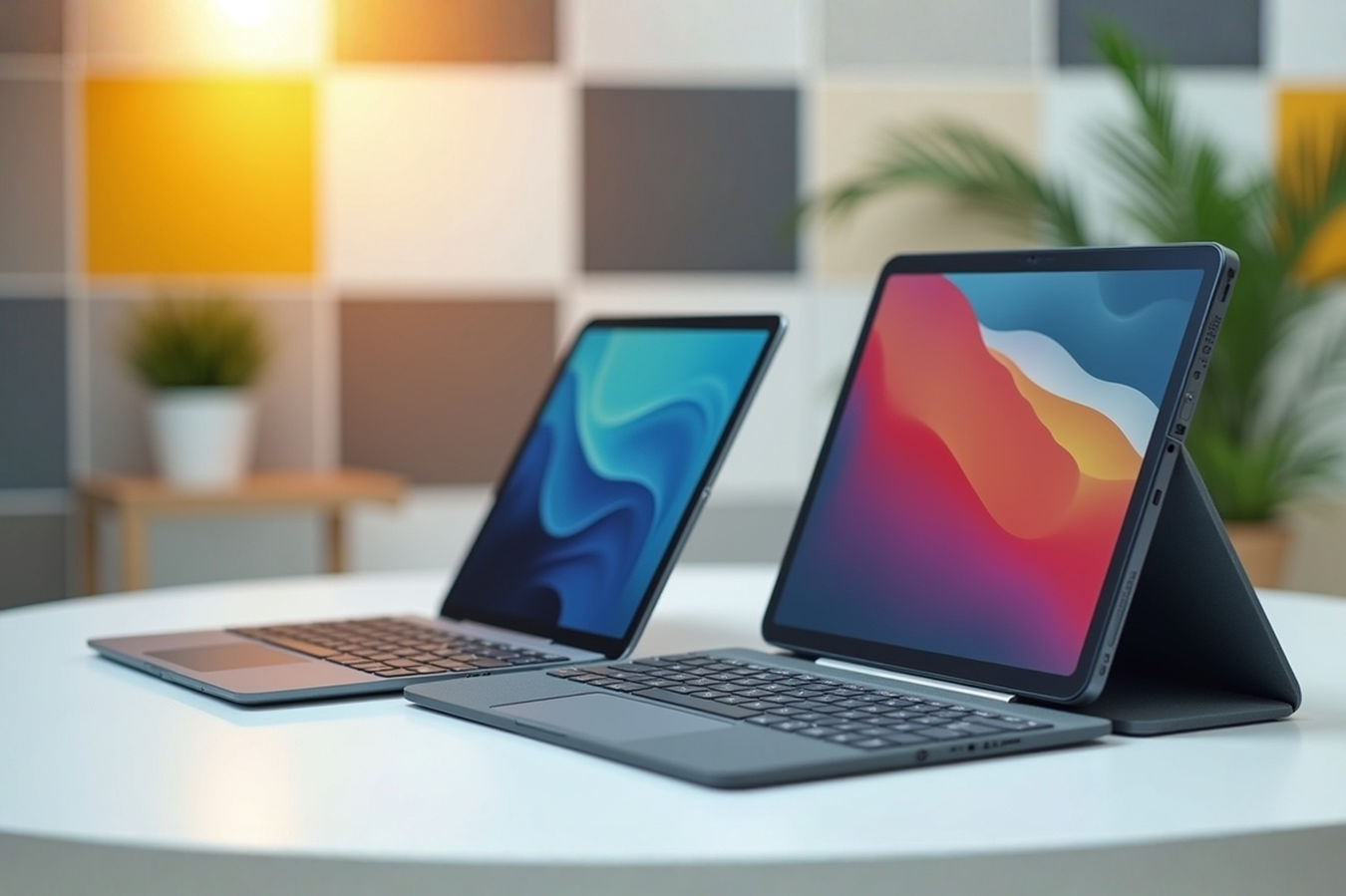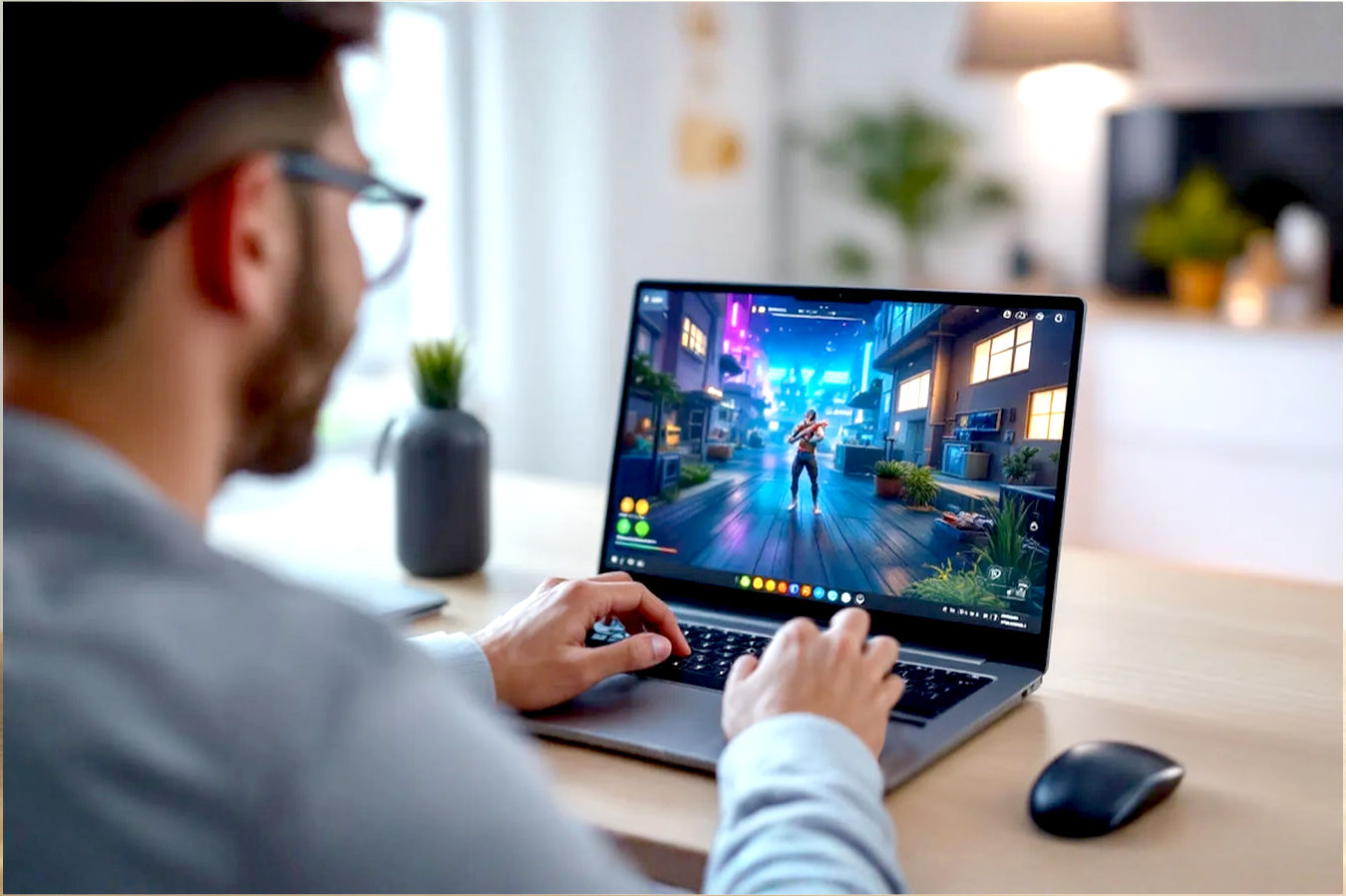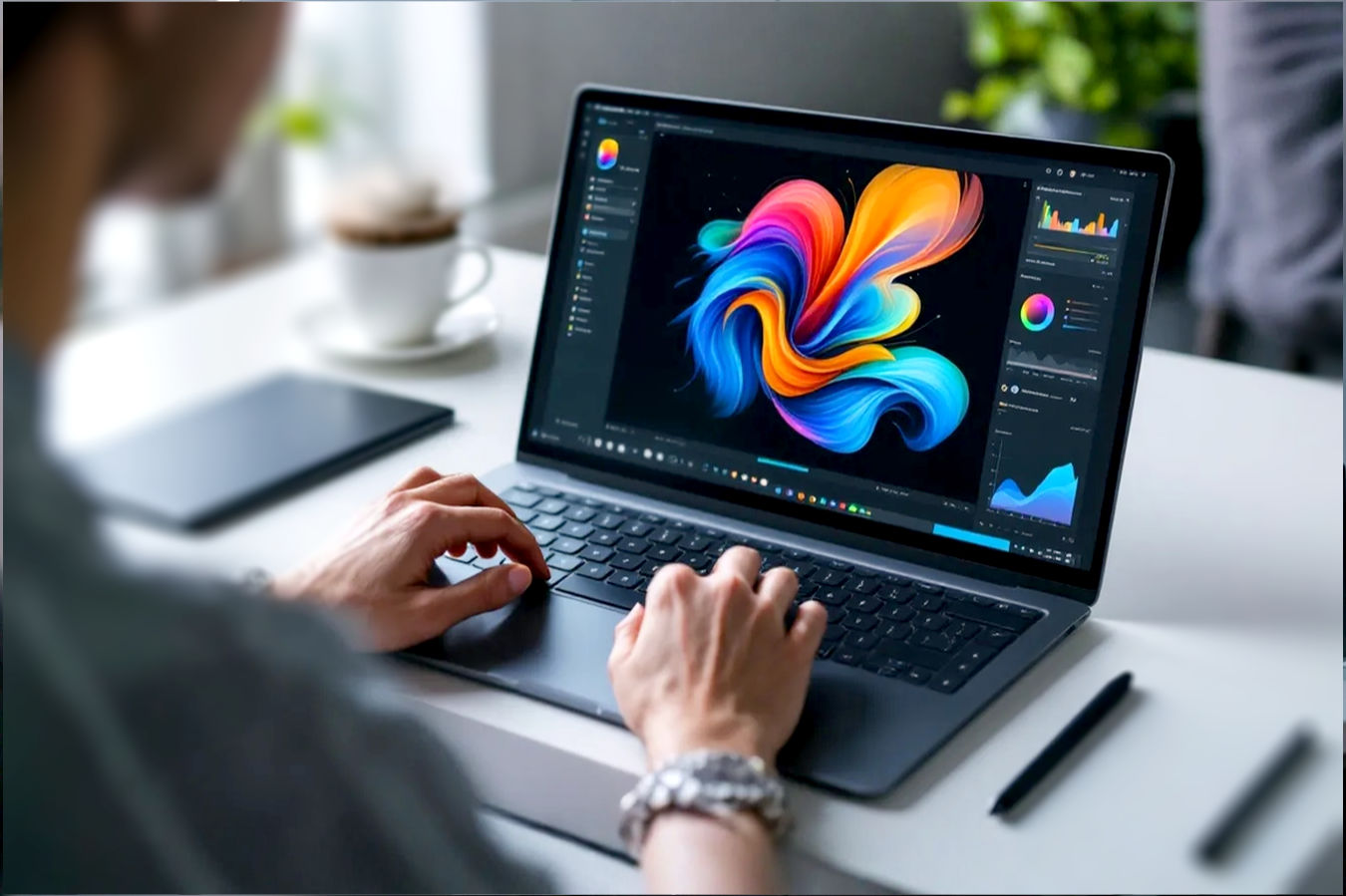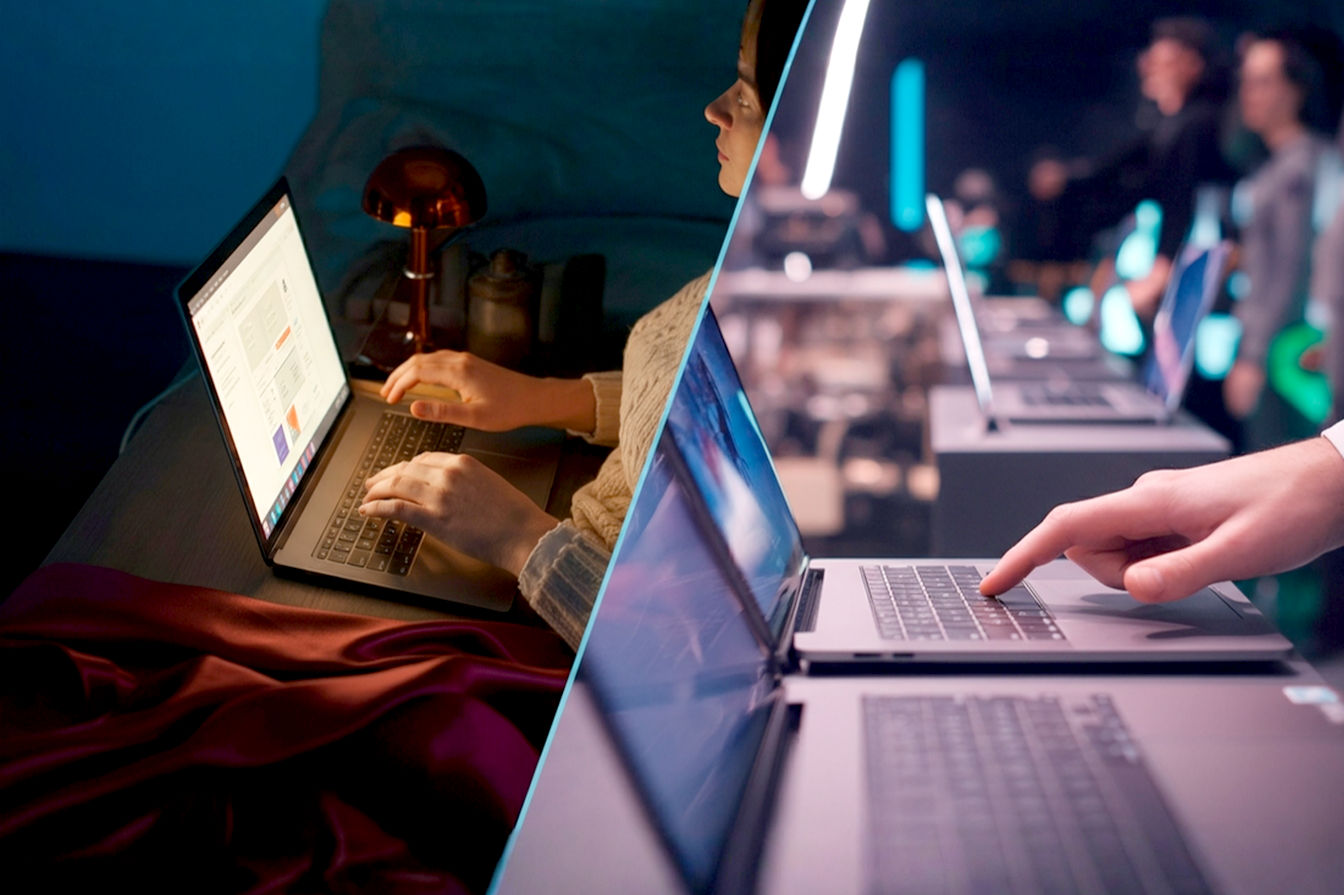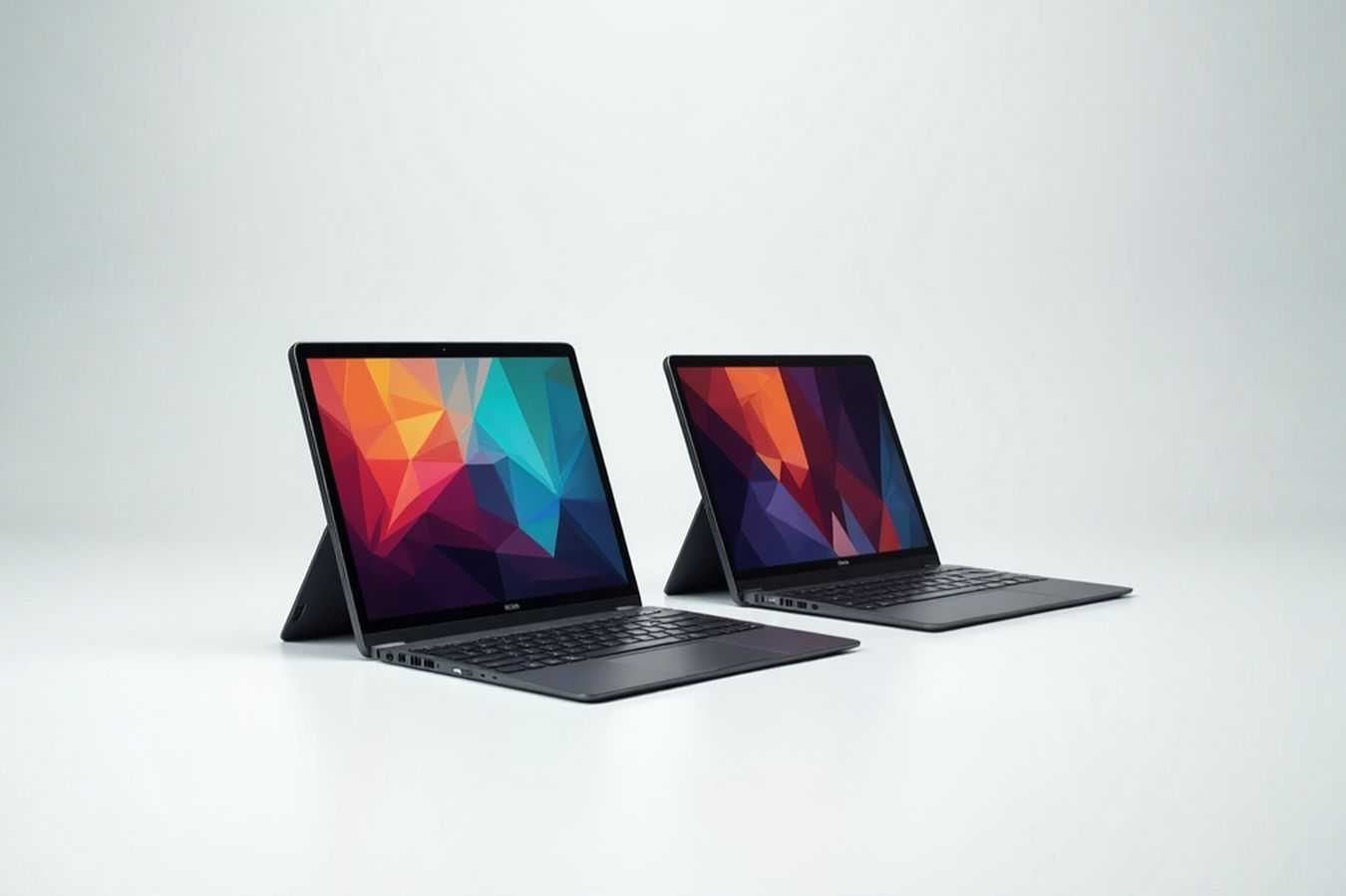This post may contain affiliate links. If you make a purchase through these links, we may earn a commission at no additional cost to you.
Choosing a new laptop can feel overwhelming, right? There are so many options out there, all promising different things. Two main types you’ll likely encounter are Ultrabooks and traditional laptops. At first glance, they both look like computers you can carry around. But scratch beneath the surface, and you’ll find some big differences, especially when it comes to balancing how easy they are to carry (portability) with how much heavy lifting they can do (power).
This guide will break down exactly what sets Ultrabooks and traditional laptops apart. We’ll look at everything from their size and weight to the kind of performance you can expect, battery life, design, and even the price tag. By the end, you’ll have a clear idea of which type might be the better fit for your needs, whether you’re a student, a professional, a creative type, or just need a reliable computer for everyday tasks.
What Exactly is an Ultrabook?
The term “Ultrabook” isn’t just a fancy marketing word; it was actually a specification and marketing term created by Intel back in 2011. Intel wanted to define a category of laptops that combined the best features of traditional laptops with the sleekness and portability of tablets. They set specific requirements that manufacturers had to meet to label a laptop an “Ultrabook.”
Think of an Ultrabook as a specific kind of thin and light laptop. It’s designed for people who need to take their computer everywhere without being weighed down. Key characteristics defined by Intel included a thin profile (usually less than 0.8 inches thick for models with screens smaller than 14 inches), light weight, fast boot times (waking up from sleep almost instantly), and decent battery life. They also had to use Intel processors.
Over the years, the specific technical requirements for Ultrabooks evolved as technology improved. But the core idea remained the same: a highly portable laptop that doesn’t sacrifice too much performance or usability compared to larger machines. They typically feature solid-state drives (SSDs) for fast storage and boot times, and they often have premium build materials like aluminum or magnesium alloy. While Intel’s strict marketing push for the “Ultrabook” brand has lessened somewhat, the characteristics they defined are now common features found in many premium thin and light laptops, even if they aren’t officially branded as “Ultrabooks.” Essentially, an Ultrabook is the poster child for modern, portable computing.
Understanding the Traditional Laptop
When we talk about a “traditional laptop,” we’re generally referring to the kind of portable computer that has been around for decades. Unlike the specific definition of an Ultrabook, “traditional laptop” is a much broader category. It includes everything from budget-friendly models designed for basic tasks to powerful workstations built for demanding professional work, and even gaming laptops packed with high-end components.
Traditional laptops come in a vast range of sizes, weights, and configurations. You can find models with screen sizes from 11 inches all the way up to 17 inches or even larger. Their weight can vary significantly, from around three or four pounds for smaller, less powerful models to seven pounds or more for larger, performance-focused machines.
The defining characteristic of a traditional laptop is its versatility and the sheer variety available. They aren’t bound by the strict size and weight constraints of Ultrabooks. This allows manufacturers to include more powerful components, larger batteries, more ports, and different types of storage (like traditional hard drives alongside or instead of SSDs). While some traditional laptops are quite sleek, the category as a whole prioritizes offering a wide spectrum of features and performance levels to suit different needs and budgets, often at the expense of ultimate portability compared to their Ultrabook cousins.
The Core Comparison: Portability
Portability is arguably the most significant difference you’ll notice right away between an Ultrabook and a traditional laptop. Ultrabooks are built with portability as a primary goal, while traditional laptops offer a wider range of portability levels.
Let’s talk about weight. Ultrabooks are designed to be as light as possible. Many weigh in at under three pounds, and some even dip below 2.5 pounds. This makes a huge difference when you’re carrying it in a backpack all day or frequently moving between locations. A traditional laptop, on the other hand, can weigh anywhere from three pounds up to seven pounds or more. Carrying a seven-pound laptop plus its charger can feel like hauling a brick after a while.
Thickness is another key factor. Ultrabooks are famously thin. The original Intel specification required them to be less than 0.8 inches thick. Modern Ultrabook-style laptops often push this even further, with some models being less than 0.6 inches thick. This slim profile makes them easy to slip into bags and gives them a sleek, modern look. Traditional laptops vary much more in thickness. Budget models or high-performance machines often need more space for components, cooling, and ports, leading to thicknesses of an inch or more.
The materials used also play a role in both weight and durability. Ultrabooks frequently use premium, lightweight materials like aluminum or magnesium alloy. These materials are not only light but also contribute to a feeling of quality and can offer better structural rigidity compared to the plastics often used in more budget-friendly traditional laptops. While high-end traditional laptops also use premium materials, the sheer volume of material needed for a larger, thicker chassis means they will still likely be heavier than an Ultrabook of comparable build quality.
Finally, form factors can impact portability. Many Ultrabooks are also available as 2-in-1 devices, meaning the screen can fold back or detach to turn the laptop into a tablet. This adds another layer of versatility for certain uses, though the 2-in-1 mechanism can sometimes add a little extra weight or thickness compared to a standard clamshell design. Traditional laptops are less commonly found in 2-in-1 configurations, though they do exist, particularly in the mid-range and higher-end business categories.
In summary, if carrying your laptop around is a major part of your daily routine, an Ultrabook offers superior portability due to its focus on minimal weight and thickness, often combined with premium, lightweight materials. Traditional laptops offer a spectrum of portability, but the most powerful ones will almost always be significantly heavier and bulkier than an Ultrabook.
The Core Comparison: Performance
While Ultrabooks prioritize portability, traditional laptops often have the edge when it comes to raw performance, especially for demanding tasks. This difference primarily comes down to the types of components they can fit inside their chassis.
Processors (CPUs) are the brain of the computer. Ultrabooks typically use Intel’s “U-series” or “Y-series” processors (like Core i5-U, i7-U). These chips are designed for efficiency, meaning they use less power and generate less heat. This allows them to be used in thin and light designs without needing massive cooling systems. However, they generally have fewer processing cores and run at lower clock speeds compared to their more powerful counterparts. A simplified explanation is they are built for energy saving, not maximum speed. The more detailed technical explanation is that U-series processors have a lower Thermal Design Power (TDP), often ranging from 15W to 28W, which limits their maximum power consumption and heat output, thus restricting their peak performance but enabling longer battery life and thinner designs.
Traditional laptops, especially larger or higher-end models, can accommodate Intel’s “H-series” processors (like Core i5-H, i7-H, i9-H) or powerful AMD Ryzen equivalents. These processors are built for performance first. They have more cores, higher clock speeds, and a much higher TDP (often 45W or more). This means they can handle complex calculations, video editing, 3D rendering, and gaming much faster. They generate more heat, requiring larger cooling systems, which contributes to the laptop’s overall size and weight. In simple terms, H-series chips are power-hungry speed demons. Technically, their higher TDP allows them to draw more power and sustain higher clock frequencies for longer periods under heavy load, resulting in significantly better performance for compute-intensive tasks.
RAM (Random Access Memory) is where your computer temporarily stores data it’s actively using. More RAM allows you to run more applications at once and handle larger files without slowing down. Ultrabooks often come with 8GB or 16GB of RAM, which is sufficient for most everyday tasks and even some moderate multitasking. Traditional laptops, particularly those aimed at professionals or gamers, can often be configured with 16GB, 32GB, or even 64GB of RAM, providing much more headroom for demanding workflows like complex simulations or editing high-resolution video.
Storage is another area where differences can exist, though the gap has narrowed. Ultrabooks almost exclusively use Solid-State Drives (SSDs). SSDs have no moving parts, making them much faster and more durable than traditional Hard Disk Drives (HDDs). They contribute significantly to the fast boot times and responsiveness of Ultrabooks. Traditional laptops can come with either SSDs, HDDs, or a combination of both. HDDs offer much larger storage capacities for a lower cost, but they are significantly slower and more prone to failure if the laptop is dropped. For maximum performance, many traditional laptops now also feature SSDs, often the faster NVMe type, but the option for high-capacity, slower HDDs still exists in some models.
Graphics capabilities are a major differentiator. Ultrabooks typically rely on integrated graphics, which are built directly into the main processor chip. These are perfectly adequate for basic tasks like browsing, watching videos, and working with documents. They can even handle some light photo editing or casual gaming. However, they lack the power for demanding graphical tasks. Traditional laptops, especially larger or gaming models, often feature dedicated graphics cards (GPUs) from companies like NVIDIA or AMD. These are separate, powerful chips specifically designed for rendering complex visuals. A dedicated GPU is essential for serious gaming, professional video editing, 3D modeling, and other graphics-intensive applications. The presence of a dedicated GPU adds significant cost, power consumption, and heat, necessitating a larger cooling system and chassis.
Finally, Cooling Systems are crucial for performance. Powerful components generate heat, and if that heat isn’t managed effectively, the components will slow down (a process called thermal throttling) to prevent damage. Ultrabooks, with their thin designs and lower-power components, have smaller, quieter cooling systems. Traditional laptops, especially those with H-series processors and dedicated GPUs, require larger fans, heat pipes, and vents to dissipate the much greater amount of heat produced. This is a primary reason why performance laptops are thicker and heavier.
In essence, while Ultrabooks offer good performance for general use and productivity within their power-efficient design, traditional laptops, particularly those with H-series processors and dedicated graphics, provide significantly more power for computationally and graphically demanding tasks. You trade some portability for that extra horsepower.
The Core Comparison: Battery Life
Battery life is a critical aspect of portability. What good is a lightweight laptop if it dies after only a couple of hours away from a power outlet? This is an area where Ultrabooks were designed to excel, though traditional laptops have also made significant improvements.
Ultrabooks are engineered for long battery life. Their use of power-efficient U-series or Y-series processors, SSDs (which use less power than HDDs), and often lower-power display panels helps them sip power rather than guzzle it. Many Ultrabooks can easily last a full workday on a single charge, with some models achieving 10, 12, or even more hours of typical use. This makes them ideal for students attending classes all day, professionals working remotely or traveling, or anyone who needs to be productive away from a power source for extended periods.
Traditional laptops show much more variation in battery life. Budget models might only last 3-4 hours. General-purpose traditional laptops can offer moderate battery life, perhaps 5-8 hours, depending on the components and battery size. High-performance traditional laptops, especially gaming laptops with powerful processors and dedicated graphics cards, often have the shortest battery life. Those power-hungry components drain the battery quickly, and while they might have physically larger batteries, the increased power consumption means they might only last 2-4 hours when performing demanding tasks.
Several factors affect battery life beyond just the type of laptop:
- Screen Brightness: A brighter screen uses significantly more power.
- Tasks Being Performed: Watching videos, running complex software, or gaming drains the battery much faster than browsing the web or typing documents.
- Wi-Fi/Bluetooth Usage: Constant searching for networks or heavy use of wireless devices consumes power.
- Battery Size: Measured in Watt-hours (Wh), a larger number generally means a larger capacity, but this must be balanced against the power consumption of the components.
- Operating System and Software Optimization: How efficiently the software manages power can have a big impact.
While Ultrabooks are generally the champions of battery life due to their power-efficient design philosophy, it’s important to check specific model reviews, as actual battery life can vary based on usage and configuration. Traditional laptops can offer decent battery life for general tasks, but high-performance models will almost always require you to stay closer to a power outlet.
Design and Build Quality
The design and build quality of a laptop contribute not only to its aesthetics but also to its durability and overall feel. This is another area where Ultrabooks often set a higher standard, though premium traditional laptops can certainly match or exceed them.
Materials are a key differentiator. As mentioned earlier, Ultrabooks frequently use premium materials like aluminum or magnesium alloy for their chassis. Aluminum provides a solid, cool-to-the-touch feel and excellent rigidity, resisting flex and bending. Magnesium alloy is even lighter than aluminum while maintaining good strength. These materials contribute to the premium look and feel that Ultrabooks are known for and offer better durability against bumps and twists compared to the plastics often used in more budget-friendly traditional laptops. While modern plastics can be quite durable, they generally don’t feel as premium and can be more susceptible to flex. Higher-end traditional laptops and mobile workstations often incorporate metal elements or full metal chassis for improved build quality.
Durability isn’t just about the chassis material. The hinge mechanism, the rigidity of the screen lid, and the overall construction all play a role. Ultrabooks are designed to be carried around frequently, so their build quality is often robust within their slim profile. However, their thinness can sometimes make them feel more fragile than a thick, solid traditional laptop. A well-built traditional laptop, even if made of plastic, can be quite durable. Ruggedized laptops, a subset of traditional laptops, are specifically designed to withstand drops, spills, and extreme conditions, something Ultrabooks are not built for.
Aesthetics are subjective, but Ultrabooks are generally designed with a focus on sleekness, minimalism, and modern appeal. Their thin profiles, often with tapered edges and clean lines, give them a premium look. Traditional laptops have a much wider range of designs, from utilitarian and boxy to sleek and stylish. Gaming laptops, a type of traditional laptop, often have aggressive designs with sharp angles and customizable RGB lighting.
The keyboard and trackpad are crucial interaction points. Because of their thinness, some Ultrabooks might have keyboards with less key travel (the distance a key moves when pressed) than thicker traditional laptops. While many modern Ultrabooks have excellent, comfortable keyboards despite this, it’s something to consider if you do a lot of typing. Trackpads on Ultrabooks are often large and use precision drivers, providing a smooth and accurate pointing experience. Traditional laptops offer a wider variety of keyboard and trackpad quality; some budget models might have small or less responsive trackpads, while high-end models can have excellent keyboards and trackpads, sometimes even including a pointing stick (like the ThinkPad’s TrackPoint) or a numeric keypad on larger models.
Overall, Ultrabooks generally offer a higher baseline of design and build quality, often utilizing premium materials for a sleek look and feel. However, the absolute most durable or feature-rich designs (like those with numeric keypads or ruggedization) are more commonly found within the broader category of traditional laptops.
Connectivity and Ports
The number and types of ports available on a laptop can significantly impact how easily you can connect external devices like monitors, external hard drives, keyboards, mice, and projectors. This is an area where the design philosophy of Ultrabooks often leads to compromises compared to traditional laptops.
Because Ultrabooks prioritize thinness, they often have a limited selection of ports. You’ll almost always find USB-C ports, which are versatile and can handle data transfer, video output (DisplayPort), and charging (Power Delivery). Many Ultrabooks rely heavily on USB-C, sometimes exclusively, especially the very thin models. Some USB-C ports on higher-end Ultrabooks also support Thunderbolt, a technology developed by Intel that offers extremely high data transfer speeds and the ability to connect multiple devices or high-resolution displays through a single port. While powerful, relying solely on USB-C often means needing adapters or docks to connect older or more common peripherals like USB-A devices, HDMI monitors, or Ethernet cables.
Traditional laptops, not being as constrained by thickness, generally offer a wider variety and greater number of ports. You’ll typically find multiple USB-A ports (the standard rectangular USB port), which are still widely used for connecting mice, keyboards, flash drives, and other accessories. Many traditional laptops also include a dedicated HDMI port for connecting to external monitors or projectors without needing an adapter. Other common ports on traditional laptops include Ethernet ports (for a wired internet connection), SD card readers (useful for photographers and videographers), and separate headphone and microphone jacks.
The presence of these additional ports on traditional laptops means you often don’t need to carry around extra adapters, making it more convenient to connect your existing devices. For users who frequently connect to various peripherals or displays, the greater port selection on a traditional laptop can be a significant advantage.
While the trend across the entire laptop market is towards more USB-C ports and fewer legacy ports, traditional laptops have been slower to adopt this change universally, particularly in the mid-range and budget segments, preserving a wider array of built-in connectivity options. If you need to connect many different types of devices without hassle, a traditional laptop is more likely to meet your needs out of the box. If you value thinness above all else and are comfortable using adapters or a dock, an Ultrabook’s port selection might be sufficient.
Display Quality
The display is your window into the computer, and its quality significantly impacts your experience, whether you’re working, watching movies, or editing photos. Both Ultrabooks and traditional laptops offer a wide range of display options, but there are some general trends.
Resolution is a key factor, determining how sharp and detailed the image is. Both types of laptops are commonly available with Full HD (1920×1080 pixels) resolution, which is perfectly adequate for most users on typical laptop screen sizes. Higher-end models in both categories offer QHD (2560×1440 or 2560×1600) or 4K (3840×2160) resolutions, providing much sharper images, especially noticeable on larger screens or when viewing detailed content. Ultrabooks, aiming for a premium experience, often feature higher-resolution displays even on smaller screen sizes, resulting in very crisp visuals.
The panel type affects color reproduction, contrast, and viewing angles. Most modern laptops, both Ultrabooks and traditional, use IPS (In-Plane Switching) panels. IPS panels offer excellent color accuracy and wide viewing angles, meaning the colors don’t look washed out when you view the screen from the side. Higher-end Ultrabooks and traditional laptops, particularly those aimed at creative professionals or users who want the best possible image quality, are increasingly offering OLED (Organic Light-Emitting Diode) displays. OLED panels provide stunning contrast ratios (true blacks), vibrant colors, and fast response times. They are generally considered superior to IPS in terms of image quality but can be more expensive and have potential issues like screen burn-in if static images are displayed for very long periods.
Brightness is measured in nits (or cd/m²). A higher nit count means a brighter screen, which is important for usability in brightly lit environments or outdoors. Ultrabooks, often designed for mobile use, tend to have brighter displays than many budget traditional laptops, with premium models reaching 400, 500, or even 600+ nits. Traditional laptops vary widely, from dim budget screens (200-250 nits) to very bright panels on high-end or professional models.
Color accuracy is crucial for tasks like photo and video editing. Displays are often rated on how much of standard color spaces (like sRGB, Adobe RGB, or DCI-P3) they can reproduce. Higher-end Ultrabooks and traditional laptops aimed at creative work often feature displays that cover 100% of the sRGB spectrum or a significant percentage of Adobe RGB or DCI-P3, ensuring that colors are displayed accurately. Budget models may have less accurate displays.
Screen size options are more varied in traditional laptops, ranging from small 11-inch models to large 17-inch or even 18-inch displays. Ultrabooks typically stick to the more portable sizes, commonly 13, 14, or 15 inches.
While excellent displays can be found in both categories, Ultrabooks generally offer a higher average quality display compared to the entire spectrum of traditional laptops, with premium features like higher resolutions, better color accuracy, and brighter panels being more common. However, the absolute best displays (e.g., large 4K OLED panels with professional-grade color accuracy) can be found in high-end traditional laptops and mobile workstations.
Price Point Comparison
Price is often a major deciding factor when buying a laptop. There’s a significant overlap in pricing between Ultrabooks and traditional laptops, but their typical ranges and what you get for your money can differ.
Ultrabooks generally occupy the mid-range to high-end price points. Because they are built with premium materials, focus on thin and light design, and often include features like SSDs and higher-quality displays as standard, their starting price is usually higher than that of a budget traditional laptop. You can expect entry-level Ultrabooks to start in the $700-$1000 range. Mid-range Ultrabooks, offering better processors, more RAM, and improved build quality, often fall between $1000 and $1500. High-end or premium Ultrabooks with top-of-the-line processors, more RAM, larger SSDs, and potentially 4K or OLED displays can easily cost $1500, $2000, or even more. You are paying a premium for the portability and refined design.
Traditional laptops have a much broader price spectrum. You can find budget traditional laptops starting as low as $300-$500. These models typically feature less powerful processors, HDDs or smaller SSDs, lower-resolution displays, and plastic builds. They are suitable for very basic tasks like web browsing, email, and word processing. The mid-range for traditional laptops is vast, spanning roughly $500 to $1200. In this range, you’ll find laptops with better processors, more RAM, SSD storage, and improved build quality and displays compared to budget models. This is where many general-purpose laptops reside. High-end traditional laptops, including powerful workstations and gaming laptops, can range from $1200 up to $3000, $4000, or even higher. These machines pack the most powerful components available, large amounts of RAM and storage, high-refresh-rate displays, and robust cooling systems.
So, while you can find a laptop in almost any price bracket, Ultrabooks tend to cluster in the higher half of the market due to their focus on premium design and components necessary for their thin and light form factor. If your budget is very tight, a traditional laptop is more likely to offer options in the sub-$700 range. If you need maximum performance regardless of portability, a high-end traditional laptop will be significantly more expensive than even a premium Ultrabook.
Who Needs Which? Use Cases
Deciding between an Ultrabook and a traditional laptop heavily depends on how you plan to use it. Different users have different priorities, and what’s perfect for one person might be completely wrong for another.
Students: For many students, portability and battery life are key. Carrying a heavy laptop across campus all day isn’t fun, and finding power outlets in classrooms can be tricky. Ultrabooks are often an excellent fit here. They are light enough to carry easily, and their long battery life means they can typically last through a full day of classes, note-taking, and research. For students in fields like graphic design or engineering who need more processing power or specialized software, a mid-range to high-end traditional laptop might be necessary, even if it means sacrificing some portability. Budget is also a factor for students, and while Ultrabooks can be pricey, there are often student discounts available, and the long-term value of a durable, portable machine can be worth the investment.
Business Professionals: Professionals on the go, who travel frequently, or who move between meeting rooms will highly value the portability and battery life of an Ultrabook. A sleek, professional-looking Ultrabook also fits well in a corporate environment. They provide enough performance for common business tasks like email, word processing, spreadsheets, presentations, and video conferencing. Security features are also important in business laptops, and both Ultrabooks and traditional business-class laptops often include features like fingerprint readers, smart card readers, and enhanced encryption options. Professionals who need to run more demanding software, such as complex data analysis tools or virtual machines, might lean towards a more powerful traditional business laptop or mobile workstation.
Creative Professionals: This group’s needs vary widely depending on their specific craft. Photographers, graphic designers, and video editors often require powerful processors, ample RAM, fast storage, and most importantly, a high-quality, color-accurate display. While some high-end Ultrabooks have excellent displays and decent performance for lighter creative work, demanding tasks like editing 4K video or complex photo manipulation often benefit significantly from the dedicated graphics cards and more powerful processors found in high-end traditional laptops or mobile workstations. The availability of multiple ports (like SD card readers and multiple USB-A ports) on traditional laptops can also be a big plus for connecting cameras, external drives, and other peripherals.
Gamers: For gamers, raw performance is usually the top priority, followed closely by cooling and display refresh rate. Gaming requires powerful processors and dedicated graphics cards, components that generate a lot of heat and require robust cooling systems. This makes gaming laptops, a subset of traditional laptops, inherently less portable than Ultrabooks. Gaming laptops are typically thicker, heavier, and have shorter battery life when gaming. While some thin and light laptops can play less demanding games, serious gamers will almost always opt for a traditional gaming laptop for the best performance and gaming experience.
Casual Users: For users who primarily use their laptop for web browsing, email, social media, streaming videos, and light productivity tasks, either an Ultrabook or a traditional laptop can work. The choice here often comes down to budget and personal preference regarding size and weight. A budget traditional laptop can easily handle these tasks at a lower price point. However, if a casual user values a premium feel, portability, and long battery life, an Ultrabook might be a worthwhile investment, even if its full performance capabilities aren’t strictly necessary for their usage.
Understanding your primary use case is the most important step in deciding which type of laptop is right for you.
Making Your Choice: Factors to Consider
With a better understanding of the differences between Ultrabooks and traditional laptops, how do you actually make your decision? It comes down to weighing your priorities across several key factors.
Your budget is often the first constraint. Determine how much you are realistically willing or able to spend. If your budget is under $700-$800, you’ll likely be looking exclusively at traditional laptops, as true Ultrabooks typically start at a higher price point. If you have a more flexible budget, you can consider both categories.
Your primary use case, as discussed in the previous section, is paramount. Are you constantly on the move and need something feather-light with all-day battery? An Ultrabook is probably your best bet. Do you need maximum processing power and graphics for demanding professional work or gaming? A traditional laptop, likely a high-end one, will be necessary. Are you a student who needs a balance of portability, battery life, and performance for coursework? Both categories offer options, but an Ultrabook might be more convenient. For basic everyday tasks, either will suffice, and budget might be the deciding factor.
What features are non-negotiable for you? Do you need a specific set of ports (like an Ethernet port or SD card reader)? Do you require a numeric keypad? Is a touch screen and 2-in-1 functionality important? Do you need a very large screen? Make a list of must-have features. Ultrabooks might lack certain ports or features commonly found on traditional laptops due to their size constraints.
Consider future-proofing. While technology evolves quickly, investing in a laptop with slightly better specs than you need right now can ensure it remains usable and performs well for longer. This might mean opting for more RAM or a slightly better processor than the minimum requirement for your current tasks. However, don’t overspend on features you’ll never use.
Finally, think about personal preference. Do you prefer a sleek, minimalist design or a more robust, feature-packed machine? Do you value a premium build feel? Are you comfortable using adapters for connectivity? Sometimes, the intangible feeling of using a device plays a role in satisfaction.
By honestly evaluating these factors – budget, primary use, required features, future-proofing, and personal preference – you can narrow down whether an Ultrabook or a traditional laptop (and what kind within that category) is the right choice for you.
The Hybrid Landscape: The Rise of 2-in-1s
The lines between different types of computing devices are constantly blurring, and the rise of 2-in-1 laptops is a perfect example of this. These devices attempt to combine the functionality of a traditional laptop with the versatility of a tablet, often fitting into the thin and light profile characteristic of Ultrabooks.
A 2-in-1 laptop typically has a touchscreen display and a hinge mechanism that allows the screen to be rotated 360 degrees to lie flat against the back of the keyboard, effectively turning the device into a tablet. Some 2-in-1s have detachable keyboards, functioning primarily as tablets with an optional keyboard attachment.
Many 2-in-1s fall under the Ultrabook umbrella because they meet the criteria for thinness, lightness, and performance using power-efficient components. They offer the portability of an Ultrabook combined with the flexibility of using the device in various modes: laptop mode for typing and productivity, tablet mode for drawing or casual use, tent mode or stand mode for presentations or watching media.
However, not all 2-in-1s are Ultrabooks. Some larger or more powerful traditional laptops also come in 2-in-1 configurations, offering touchscreens and flexible hinges but without necessarily meeting the strict weight and thickness requirements of an Ultrabook.
The existence of 2-in-1s highlights that the choice isn’t always a simple either/or between a pure Ultrabook and a pure traditional laptop. These hybrid devices offer a compelling option for users who want the portability of an Ultrabook but also value the versatility of a touchscreen and multiple form factors for different tasks or environments. They represent a middle ground, blending features from both worlds.
Conclusion
In the end, the question of whether an Ultrabook or a traditional laptop offers “more portable power” doesn’t have a single, universal answer. It entirely depends on what you mean by “portable power” and what your individual needs and priorities are.
If “portable power” means a device that is incredibly easy to carry around all day, fits into tight spaces, lasts a long time on battery, and provides enough performance for everyday tasks and productivity, then an Ultrabook is likely the champion. You get excellent portability, a premium design, and solid performance for general use, making them ideal for mobile professionals and many students.
If “portable power” means a device that can handle the most demanding software, complex calculations, professional creative work, or serious gaming, even if it means carrying a heavier and bulkier machine, then a traditional laptop, particularly a high-end or specialized model, offers significantly more raw power. You sacrifice some ease of carrying for the ability to run resource-intensive applications smoothly.
Traditional laptops also offer a much wider range of options across all price points and configurations. If your budget is limited, or you need specific features like a large number of legacy ports or a very large screen, a traditional laptop is more likely to meet your needs.
Ultimately, the best way to make your decision is to carefully consider your budget, your primary use cases, the specific features you require, and how much you value portability versus maximum performance. Don’t just look at the labels “Ultrabook” or “traditional laptop”; dive into the specific specifications of individual models. Read reviews, compare benchmarks, and if possible, try them out in person to get a feel for their size, weight, keyboard, and display. By doing your homework and understanding what each type offers, you can confidently choose the laptop that provides the right balance of portability and power for you.


